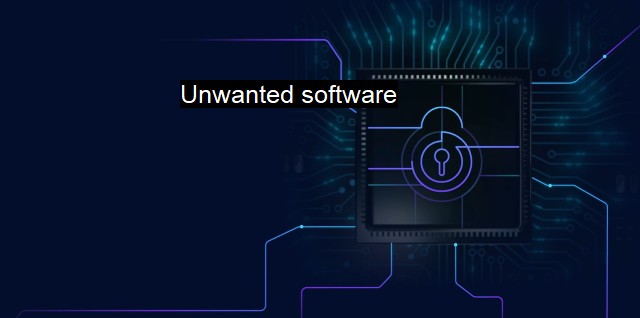What is Unwanted software?
The Dangers of Unwanted Software: Adware, Spyware, and More – How to Protect Your Device and Data
Unwanted software, often referred to as Potentially Unwanted Programs (PUPs) or Potentially Unwanted Applications (PUAs), represents a significant challenge within the cybersecurity field. Unwanted software typically infiltrates a system without the user's full understanding or permission, resulting in a range of disruptive effects and potential security threats.Unwanted software consists of applications and systems that, while not overtly malicious by intent, are nonetheless capable of causing problems for users and their devices. Many of these programs engage in activities that undermine system performance, interfere with user control, or compromise data. Given the pervasive nature of unwanted software, it has become the focus of antivirus tools and cybersecurity professionals worldwide.
Many users unwittingly install unwanted software simply by surfing the internet, with these programs often hidden within otherwise legitimate software downloads. This tactic of bundled distribution is very common especially among free applications, where the money is made through advertising and data selling, as some PUPs might include tracking functions to gather user data.
Unwanted software can manifest in various forms such as adware, spyware, or browser hijackers. Adware inundates users with unsolicited adverts, often tailored to browsing history gathered from unjustly tracking a user's activity. Spyware collects user's sensitive data, such as logging keystrokes to gather passwords, without their knowledge. Browser hijackers alter browser settings to redirect users to specific websites for driving ad revenue.
Even though there's confusing terminology surrounding unwanted software, malware, and viruses, each term describes different threats within cybersecurity. Malware is a catch-all phrase for any software created with malicious intent, whether viruses, worms, trojan horses, ransomware, or other forms. Viruses are a particular type of malware, capable of self-replication and designed to damage systems or steal data. Conversely, unwanted software isn't necessarily created with harmful purposes but poses significant issues by invading privacy, affecting system performance, or causing user annoyance.
Antivirus software is a crucial tool in the detection and elimination of unwanted software. Good antivirus software scans, identifies and removes unwanted software, in addition to its role in mitigating more serious systemic threats from viruses and malicious software. many antivirus programs now include real-time protection and browser extensions, identifying potentially dangerous websites, and blocking downloads that may contain PUPs embedded in them.
Avoiding unwanted software demands a robust approach beyond just antivirus software. The awareness and informed actions of users is integral. Users should download from trusted sources, understand the permissions that they grant to applications, and regularly update their devices to latest software versions. Reading Terms and Conditions, while admittedly tedious, could help identify if the software includes potential unwanted add-ons.
To sum up, unwanted software, thought not always technically a security threat, undermines user controls, diminishes system performance, and can compromise privacy. The potential for such software to become a conduit for more serious system-level threats underscores the importance of preventing their installation. Cybersecurity involves technical measures like antivirus software and requires both awareness and thoughtful action from users. One thing is unequivocal; the fight against unwanted software is amongst the most pressing challenges facing today's digital world.

Unwanted software FAQs
What is unwanted software?
Unwanted software is a term used to refer to any program or application that has been installed on a computer without the user's knowledge or consent, and that typically performs actions that the user did not intend. Unwanted software is often classified as potentially unwanted programs (PUPs) or malware, depending on its behavior.How does unwanted software affect cybersecurity?
Unwanted software can pose a significant threat to cybersecurity, as it often contains malicious code that can compromise the security of a system or network. Some types of unwanted software, such as spyware, adware, and ransomware, can collect sensitive information or hijack system resources, while others can be used to launch cyber attacks or spread malware.How can I protect my computer from unwanted software?
There are several steps you can take to protect your computer from unwanted software, including installing a reputable antivirus program, keeping your software up to date, avoiding downloading software from untrusted sources, and being cautious when clicking on links or downloading email attachments. You should also consider using a firewall, disabling automatic downloads, and regularly scanning your system for malware.What should I do if I suspect that my computer has unwanted software?
If you suspect that your computer has unwanted software installed on it, you should immediately disconnect it from the internet and run a full system scan using your antivirus software. You should also remove any suspicious programs or files from your computer, and change your passwords for any online accounts that may have been compromised. If you are unable to remove the unwanted software yourself, you may need to seek assistance from a professional IT service or cybersecurity expert.| | A | | | B | | | C | | | D | | | E | | | F | | | G | | | H | | | I | | | J | | | K | | | L | | | M | |
| | N | | | O | | | P | | | Q | | | R | | | S | | | T | | | U | | | V | | | W | | | X | | | Y | | | Z | |
| | 1 | | | 2 | | | 3 | | | 4 | | | 7 | | | 8 | | |||||||